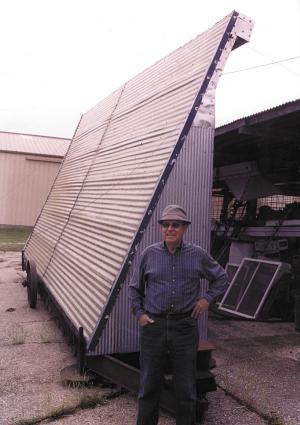2006 - Volume #30, Issue #5, Page #19
[ Sample Stories From This Issue | List of All Stories In This Issue | Print this story
| Read this issue]
Solar Collector Keeps Basement Toasty Warm
 |
The collector measures 24 ft. long by 12 ft. high and is 4 ft. wide at the base. It mounts on a steel-wheeled trailer so it can be easily moved. He has a workshop in the north side of his basement so he keeps the collector on the north side of the house, running insulated ductwork from the collector through a basement window.
The collector consists of a sheet of clear fiberglass on the outside with a sheet of aluminum, painted black, to absorb heat behind it that's screwed to sheets of plywood. There's 4 in. of space between the fiberglass and the aluminum. The back side of the plywood is covered by 1-in. thick Styrofoam insulation board. The insulation board attaches to a frame made from 2 by 4's.
Cold air enters through an opening at the bottom of one end of the collector. The air is drawn in by a 10-in. fan that sets inside a 2-ft. sq. wooden box on the collector's floor, at the opposite end of the intake. The air zig zags back and forth from one side of the collector to the other, traveling through 8-in. wide notches that he cut into the 2 by 4's in the frame, and ends up at the top of the collector. The hot air is then drawn by the fan down through a double insulated fiberglass pipe back down into the box, where it continues through another fiberglass pipe into the basement.
"Even if the outside temperature is only 10 degrees, as long as the sun is shining the temperature in the basement will rise by two to four degrees during the day. However, it doesn't produce enough heat for my entire 2,200 sq. ft. house," says Reissner. "It also doesn't produce much heat on cloudy winter days. It could probably provide more heat, but I didn't want to spend money on an automatic thermostat system until I was sure how well it would work.
"I spent about $1,000 to build it, mostly for the fiberglass and insulation. I applied two coats of black paint made specially for barbeque grills. It costs $250 per gallon."
Reisner also tried using the solar collector to dry corn in a 25,000 bu. grain bin. "I only used it on three loads of corn. I used an aeration fan to suck air through the corn but didn't get enough air movement to do much good. It didn't help that the corn was wet, at 20 to 21 percent moisture," notes Reissner.
Contact: FARM SHOW Followup, George Reisner, 7409 2050 Ave., Jewett, Ill. 62436 (ph 217 683-2318).

Click here to download page story appeared in.

Click here to read entire issue
To read the rest of this story, download this issue below or click here to register with your account number.




